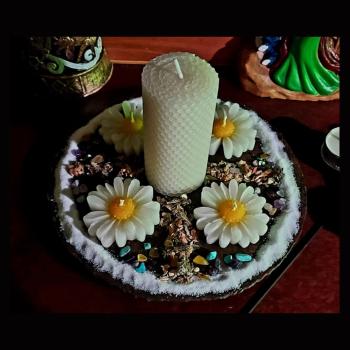Rosh Hashonah is the day that Adam was created and recognized God as running the show (and being all there is) thereby acting as the "kingdom" by which God becomes "King." Jewishly, "kingship" implies a kingdom that accepts the king as king over itself, whereas "rulership" can apply to someone who imposes his will upon the entity he rules over regardless of that entity's awareness or acceptance of him as ruler. Thus, Rosh Hashonah is all about our "elevating God's kingship," that is, act as the "kingdom" by which God becomes "King." (Additionally, Rosh Hashonah marks the beginning of a new yearly cycle, and, thus, is associated with the concept of renewal in general. Hence, just as the prophets would receive a"sign" as the start of the actualization of their prophecy, so too, we are involved in eating certain foodsas a way of attaching ourselves to them and the "signs"they represent, in order that they be the "preparation" for the actualization of a good decree.)
It comes out that the primary goal of Rosh Hashonah is not personal change or repentance. Rather, personal change and repentance are outgrowths and ramifications of the Rosh Hashonah experience of internalizing the reality of God's kingship. Thus, Rosh Hashonah stands as a springboard at the onset of the Ten Days of Repentance, which ultimately culminates with Yom Kippur (the Day of Atonement) on which we divorce ourselves from physicality (no eating, drinking, bathing, marital intimacy) and are immersed in introspection and ascend, in a sense, to the level of angels.
Making the Ideal Real
Interestingly, the first thing we are to do after Yom Kipper (once having eaten) according to Jewish law, is to begin to build one's sukkah, one's temporary dwelling place for the holiday of Sukkot.
At first glance, this is a very puzzling transition; we are moving from the mitzvah that is most divorced from the physical world (Yom Kippur) to the mitzvah that is most involved in the physical world (building a sukkah).
However, upon further investigation, we come to realize that Sukkot is about our taking the clarity and consciousness achieved on Yom Kippur and bringing it into the physical world.
For the holiday of Sukkot, we build a house, but it's a temporary house, the roof of which is built with materials that are normally discarded. We are coming to Sukkot with the clarity of Yom Kippur—clarity on the spiritual, clarity on our purpose, and clarity on the fact that all is dependent on God and that God is truly all there is—and we are moving with that clarity into the physical world.
Jewish Joy
This is the essence of joy. Joy is the experience of actualizing the reality of who you are. On Rosh Hashonah we achieve the awareness of that reality. On Yom Kippur we gain a perfected and clarified consciousness of that reality. And on Sukkot, we live out that reality in our physical day-to-day domain.
In fact, as we will now explain, the Sukkot experience is our living out of this reality in the three dimensions of the physical: in Time, in Space, and in Being. In Time, we are living out this reality for seven days beginning from the 15th of the Hebrew month of Tishrei, since the symbolic significance of the number seven is completion in the natural world and the 15th of Tishrei is the strongest expression of the Tishrei energy of returning the holiness and wholiness. In Being, the "presence" of the Seven Shepherds who personify Godly traits in the physical world "visit" us throughout the holiday. And, in Space, the physical objects of the Four Species hint to those Seven Shepherds and, by extension, the Godly traits that they personify.
Three Dimensions of Sukkot
In the dimension of Being, we are "visited" and strengthened by the Seven Shepherds who lived out the reality of God to the point of becoming the personifications of Godly traits in the world.
In the dimension of Space, we take the Four Species, consisting of three myrtle branches, two willow branches, one palm branch, and one citron. The three myrtle branches hint to the three patriarchs Abraham, Isaac, and Jacob, since the myrtle leaf has the shape of an eye and the patriarchs are the vision of the nation. The two willow branches hint to Moses and Aaron, since the willow leaf has the shape of lips and Moses and Aaron taught the Torah to the nation of Israel. The palm branch hints to Joseph, since the palm branch has the shape of the spine and Joseph is the staple righteous person that is the backbone of the Jewish people because of his ongoing rising above sexual temptations in Egypt. The citron hints to King David, since the citron has the shape of a heart and King David was the impassioned singer of Psalms to God.
In the dimension of Time, the celebration of Sukkot is for seven days because the number seven indicates completion in the natural world in which we live. After all, everything in the physical has six sides: up, down, left, right, front, back; this is physical space in its complete form. (Thus, God created the physical world in six days.) But there is also a nonphysical midpoint, the spiritual core from which the physical sides draw the energy for their existence. That is, the concepts of up, down, left, right, front, and back do not consist of any essential existence. Rather, up, down, left, right, front, and back are all relative to their midpoint, the existence of which is so total that it cannot be pointed to since anything that can be pointed to exists in the physical and, thus, can be further broken down. (Similarly, we take the seven components of the Four Species and shake them in all six directions while we act as the seventh—i.e., the midpoint.)





